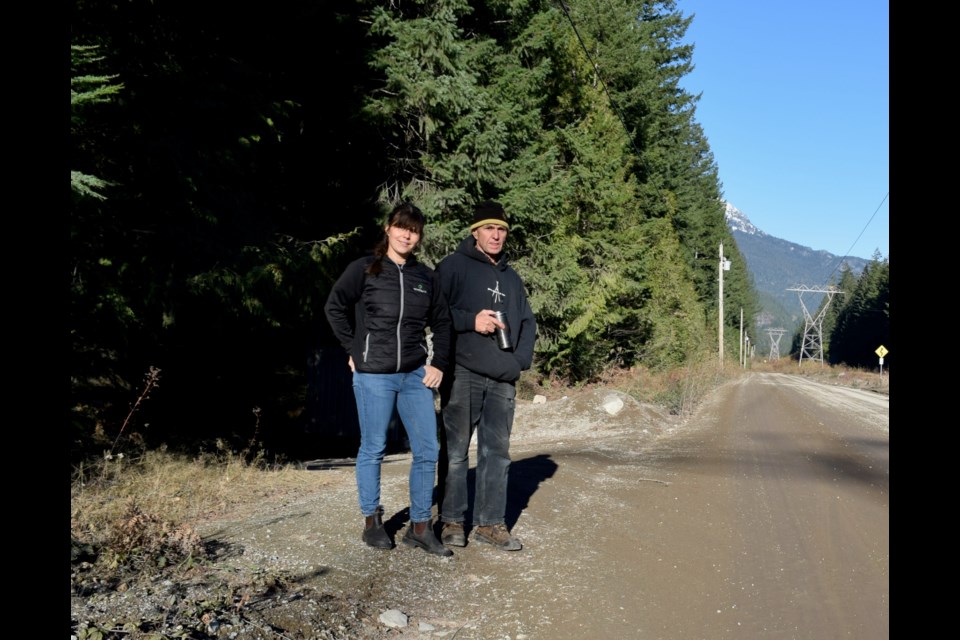As you drive down Paradise Valley Road, the smooth paved road suddenly becomes a bumpy gravel dirt road.
On a sunny Thursday morning, cars go by at frequent intervals.
Those vehicles that don't slow down, kick up rocks as they go.
This is a good day, says resident Rebecca Spitzer, who has lived along the road since 1987.
It is a crisp sunny morning, and it hasn't rained or been excessively dry recently, so she said the potholes aren't too bad.
Though the road is relatively busy for a rural weekday morning, this day's traffic is nothing compared to in the summer, she said.
During the warmer months, she and her family don't even like to leave their house due to the dust and traffic.
Spitzer and a few other residents of the area are calling on the District, which has jurisdiction over the road, to pay it more attention.
Resident Ron Drewry sent an open letter to Squamish council calling for the road to be better maintained.
"Even on the odd occasion when the road is graded, the road surface only lasts a day or two before it is once again impassable, as there is no aggregate to grade, only mud and dust," he said in his letter.
The summers are the worst, echoed Peter Spitzer, Rebecca's father.
"The dust is the worst from April, basically, to October. We have nothing but dust," he said.
Ultimately, the road should be paved, the residents say.
Decades ago, when the Spitzers first moved to the location, Squamish was a small community and not many folks ventured out that way to recreate.
Now, the town is booming, and the Sea to Sky Trail, bed and breakfasts, rafting tours and other Instagram-worthy locations are promoted.
"More and more people come out here every weekend, especially in the summer," Peter said.
Rebecca noted that in the summer, the dust collects in their household filter and they avoid being outside in the yard for the dust.
Peter said the District should test the air quality in the summer to see how hard it is to breathe when dust is kicked up.
Same with the traffic, he said.
"They measure how much traffic goes and that'll justify a paving job," he said.
Rebecca added that the road is both a health and safety issue.
"I don't personally ride my horse anymore on the weekends — up that way, down this way. There is way too much traffic flying past you," she said.
She also noted that the road doesn't have proper water runoff.
She worries if first responders had to come out that way and time was of the essence given how bad the road can be at times.
It will slow response times, she said.
Asked if paving wouldn't increase speeding and visitors, the Spitzers say both are already happening. They suggested that removable speed bumps could be put in for the summer season.
The way it is now, folks think it is a rural area and behave as such when there are residents there, said Peter, recalling people shooting rifles right across the street from his home; there is also a lot of garbage dumping in the area.
"[The dirt road] just suggests to people that they are not in the municipality," he said.
He also notes that 30 years ago, he paid $350 in taxes; now it is $8,700, and there haven't been infrastructure improvements.
"There's no improvement whatsoever. The opposite happened — it got worse," he said.
Rebecca added that the road doesn't have proper ditching or ability for runoff.
"The water just sits. It doesn't go anywhere."
Would cost $1 million to pave, says District
A spokesperson for the District said, from a budget standpoint, the cost of paving, rebuilding and drainage is significant.
“And so this rural road that services a few properties within the District of Squamish needs to be weighed against all other community priorities,” said Rachel Boguski, media spokesperson for the District, in an email to The Squamish Chief.
It’s estimated that the cost of paving would be approximately $1 million, according to the District.
“It should also be noted that the road is in part on the land that is privately owned and operated by BC Hydro, and any upgrades may require land acquisition,” Boguski said.
“The District performs ongoing road maintenance, including dust abatement, snow plowing and road grading to ensure the roads are safe and useable for the homes within the District of Squamish, as well as those homes within the Squamish-Lillooet Regional District who access their part of the road via the District road.”
The District of Squamish says in 2015, a portion of Paradise Valley Road — the first third of the road — was completely rebuilt after flooding.
Sections of the road are resurfaced on an ongoing basis; approximately 30 to 40 loads of gravel were used last year, according to the District.
“The frequency of grading is weather-dependent. With 13.5 kilometres of gravel roads in Squamish, we are constrained by — often brief — weather windows during rainy months in terms of the amount of grading that can be done across the community,” Boguski said.
Dust abatement now takes place three to five times per year, according to Boguski, since the municipality changed to a more cost-effective product two years ago.
“Dust abatement is weather dependent, as in order to successfully eliminate dust, the application of the product must be done before a lengthy spell of hot, dry weather ... If the product is applied too early in the season or before an anticipated rainfall … the dust will return and remain for the rest of the summer.”




